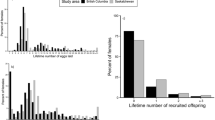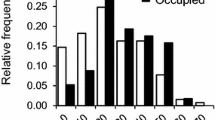Abstract
Questions about individual variation in “quality” and fitness are of great interest to evolutionary and population ecologists. Such variation can be investigated using either a random effects approach or an approach that relies on identifying observable traits that are themselves correlated with fitness components. We used the latter approach with data from 1,925 individual females of three species of ducks (tufted duck, Aythya fuligula; common pochard, Aythya ferina; northern shoveler, Anas clypeata) sampled on their breeding grounds at Engure Marsh, Latvia, for over 15 years. Based on associations with reproductive output, we selected two traits, one morphological (relative body condition) and one behavioral (relative time of nesting), that can be used to characterize individual females over their lifetimes. We then asked whether these traits were related to annual survival probabilities of nesting females. We hypothesized quadratic, rather than monotonic, relationships based loosely on ideas about the likely action of stabilizing selection on these two traits. Parameters of these relationships were estimated directly using ultrastructural models embedded within capture-recapture-band-recovery models. Results provided evidence that both traits were related to survival in the hypothesized manner. For all three species, females that tended to nest earlier than the norm exhibited the highest survival rates, but very early nesters experienced reduced survival and late nesters showed even lower survival. For shovelers, females in average body condition showed the highest survival, with lower survival rates exhibited by both heavy and light birds. For common pochard and tufted duck, the highest survival rates were associated with birds of slightly above-average condition, with somewhat lower survival for very heavy birds and much lower survival for birds in relatively poor condition. Based on results from this study and previous work on reproduction, we conclude that nest initiation date and body condition covary with both reproductive and survival components of fitness. These associations lead to a positive covariance of these two fitness components within individuals and to the conclusion that these two traits are indeed correlates of individual quality.


Similar content being viewed by others
References
Anderson MG, Lindberg MS, Emery RB (2001) Probability of survival and breeding for juvenile female Canvasbacks. J Wildl Manage 65:385–397
Ankney CD, Afton AD, Alisauskas RT (1991) The role of nutrient reserves in limiting waterfowl reproduction. Condor 93:1029–1032
Blackenhorn WU (2000) The evolution of body size: what keeps organisms small? Q Rev Biol 75:385–407
Blums P, Clark RG (2004) Correlates of lifetime reproductive success in three species of European ducks. Oecologia 140:61–67
Blums P, Reders V, Mednis A, Baumanis J (1983) Automatic drop-door traps for ducks. J Wildl Manage 47:199–203
Blums P, Mednis A, Bauga I, Nichols JD, Hines JE (1996) Age-specific survival and philopatry in three species of European ducks: a long-term study. Condor 98:61–74
Blums P, Mednis A, Clark RG (1997) Effect of incubation body mass on reproductive success and survival of three European diving ducks: a test of the nutrient limitation hypothesis. Condor 99:916–925
Blums P, Clark RG, Mednis A (2002a) Patterns of reproductive effort and success in birds: path analyses of long-term data from European ducks. J Anim Ecol 71:280–295
Blums P, Nichols JD, Hines JE, Mednis A (2002b) Sources of variation in survival and breeding site fidelity in three species of European ducks. J Anim Ecol 71:438–450
Blums P, Nichols JD, Lindberg MS, Hines JE, Mednis A (2003) Factors affecting breeding dispersal of European ducks on Engure Marsh, Latvia. J Anim Ecol 72:292–307
Brinkhof MWG, Cave AJ, Daan S, Perdeck AC (2002) Timing of current reproduction directly affects future reproductive output in European Coots. Evolution 56:400–411
Burnham KP (1993) A theory for combined analysis of ring recovery and recapture data. In: Lebreton J-D, North PM (eds) Marked individuals in the study of bird population. Birkhauser, Basel, pp 199–213
Burnham KP, Anderson DR (2002) Model selection and multi-model inference. Springer, Berlin Heidelberg New York
Cam E, Link WA, Cooch EG, Monnat J-Y, Danchin E (2002) Individual variation in life-history traits: seeing the trees despite the forest. Am Nat 159:96–105
Caswell H (2001) Matrix population models, 2nd edn. Sinauer, Sunderland, Mass.
Charlesworth B (1980) Evolution in age-structured populations. Cambridge University Press, Cambridge
Clutton-Brock TH (1988) Reproductive success. University of Chicago Press, Chicago
Cohen JE (1986) An uncertainty principle in demography and the unisex issue. Am Stat 40:32–39
Conroy MJ, Costanzo GR, Stotts DB (1989) Winter survival of female American black ducks on the Atlantic Coast. J Wildl Manage 53:99–109
Cooch EG (2002) Fledging size and survival in snow geese: timing is everything (or is it?). J Appl Stat 29:143–162
Cooch EG, White GW (2004) Using MARK: a gentle introduction, 3rd edn. Available at http://www.phidot.org/software/mark/docs/book/
Cooch EG, Cam E, Link WA (2002) Occam’s revenge: levels of analysis in evolutionary ecology—where to next? J Appl Stat 29:19–48
Cooke F, Findlay CS, Rockwell RF (1984) Recruitment and the timing of reproduction in Lesser Snow Geese (Chen caerulescens caerulescens). Auk 101:451–458
Crow JF, Kimura M (1970) An introduction to population genetics theory. Harper and Row, New York
Daan S, Dijkstra C, Tinbergen JM (1990) Family planning in the kestrel (Falco tinnunculus): the ultimate control of covariation of laying date and clutch size. Behaviour 114:83–116
DeAngelis DL, Gross LJ (1992) Individual-based models and approaches in ecology. Chapman and Hall, New York
Dufour KW, Ankney CD, Weatherhead PJ (1993) Condition and vulnerability to hunting among mallards staging at Lake St. Clair, Ontario. J Wildl Manage 57:209–215
Ferriere R, Le Gaillard J-F (2001) Invasion fitness and adaptive dynamics in spatial population models. In: Clobert J, Danchin E, Dhondt AA, Nichols JD (eds) Dispersal. Oxford University Press, Oxford, pp 57–79
Fisher RA (1930) The genetical theory of natural selection. Clarendon Press, Oxford
Francis, CM, Richards MH, Cooke F, Rockwell RF (1992) Long-term changes in the survival of lesser snow geese. Ecology 73:1346–1362
Gosler AG, Greenwood JDJ, Perrins C (1995) Predation risk and the cost of being fat. Nature 377:621–623
Haramis GM, Nichols JD, Pollock KH, Hines JE (1986) The relationship between body mass and survival of wintering canvasbacks. Auk 103:506–514
Hepp GR, Blohm RJ, Reynolds RE, Hines JE, Nichols JD (1986) Physiological condition of autumn-banded mallards and its relationship to hunting vulnerability. J Wildl Manage 50:177–183
Hill MRJ, Alisauskas RT, Ankney CD, Leafloor JO (2003) Influence of body size and condition on harvest and survival of juvenile Canada geese. J Wildl Manage 67:530–541
Johnson DH, Nichols JD, Schwartz MD (1992) Population dynamics of breeding waterfowl. In: Batt BDJ, Afton AD, Anderson MG, Ankney CD, Johnson DH, Kadlec JA, Krapu GL (eds) Ecology and management of breeding waterfowl. University of Minnesota Press, Minneapolis, pp 446–485
Koivula K, Orell M, Lahti K (2002) Plastic daily fattening routines in willow tits. J Anim Ecol 71:816–823
Langston NE, Freeman S, Rohwer S, Gori D (1990) The evolution of female body size in Red-winged Blackbirds: the effects of timing of breeding, social competition, and reproductive energetics. Evolution 44:1764–1779
Lefkovitch LP (1965) The study of population growth in organisms grouped by stages. Biometrics 21:1–18
Leslie PH (1945) On the use of matrices in certain population mathematics. Biometrika 33:183–212
Link W, Cooch E, Cam E (2002) Model-based individual fitness. J Appl Stat 29:207–224
Lomnicki A (1988) Population ecology of individuals. Princeton University Press, Princeton
Manton KG, Stallard E, Vaupel JW (1981) Methods for comparing the mortality experience of heterogeneous populations. Demography 18:389–410
Metz JAJ, Nisbet RM, Geritz SAH (1992) How should we define ‘fitness’ for general ecological scenarios? Trends Ecol Evol 7:198–202
Monaghan P, Metcalfe NB (1986) On being the right size: natural selection and body size in the Herring Gull. Evolution 40:1096–1099
Newton I (1989) Lifetime reproduction in birds. Academic Press, London
Nichols JD (2002) Discussion comments on “Occam’s shadow levels of analysis in evolutionary ecology: where to next?” by Cooch, Cam and Link. J Appl Stat 29:49–52
Nichols JD, Hines JE, Blums P (1997) Tests for senescent decline in annual survival probabilities of common pochards, Aythya ferina. Ecology 78:1009–1018
Nilsson J-A (1999) Fitness consequences of timing of reproduction. Proc Int Ornithol Congr 22:234–247
Owen M, Black JM (1989) Factors affecting the survival of barnacle geese on migration from the breeding grounds. J Anim Ecol 58:603–617
Pace RM, Afton AD (1999) Direct recovery rates of lesser scaup banded in Northwest Minnesota: sources of heterogeneity. J Wildl Manage 63:389–395
Pollock KH, Winterstein SR, Conroy MJ (1989) Estimation and analysis of survival distributions for radio-tagged animals. Biometrics 45:99–109
Reinecke KJ, Stone TL, Owen RB Jr (1982) Seasonal carcass composition and energy balance of female black ducks in Maine. Condor 84:420–426
Roff DA (2002) Life history evolution. Sinauer, Sunderland, Mass.
Rohwer FC (1992) The evolution of reproductive patterns in waterfowl. In: Batt BDJ, Afton AD, Anderson MG, Ankney CD, Johnson DH, Kadlec JA, Krapu GL (eds) Ecology and management of breeding waterfowl. University of Minnesota Press, Minneapolis, pp 486–539
Rohwer FC, Heusmann HW (1991) Effects of brood size and age on survival of female Wood Ducks. Condor 93:817–824
Rotella JJ, Clark RG, Afton AD (2003) Survival of female lesser scaup: effect of body size, age, and reproductive effort. Condor 105:336–347
Schmutz JA (1993) Survival and pre-fledging body mass in juvenile emperor geese. Condor 95:222–226
Sedinger JS, Flint PL, Lindberg MS (1995) Environmental influence on life-history traits: growth, survival, and fecundity in black brant (Branta bernicla). Ecology 76:2404–2414
Simpson EH (1951) The interpretation of interaction in contingency tables. J R Stat Soc Ser B 13:238–241
Slattery SM, Alisauskas RT (2002) Use of the Barker model in an experiment examining covariate effects on first-year survival in Ross’s geese (Chen rossii): a case study. J Appl Stat 29:497–508
Stearns SC (1992) The evolution of life-histories. Oxford University Press, Oxford
Viksne J (2000) Changes of nesting bird fauna at the Engure Ramsar Site, Latvia, during the last 50 years. Proc Latvian Acad Sci Sect B 54:213–220
Weatherhead PJ, Clark RG (1994) Natural selection and sexual size dimorphism in Red-winged Blackbirds. Evolution 48:1071–1079
White GC, Burnham KP (1999) Program MARK: survival estimation from populations of marked animals. Bird Study 46 [Suppl]:S120–S139
White GC, Burnham KP, Anderson DR (2001) Advanced features of program MARK. In: Field R, Warren RJ, Okarma H, Sievert PR (eds) Wildlife, land, and people: priorities for the 21st century. Proceedings of the international wildlife conference. The Wildlife Society, Bethesda, pp 368–377
Acknowledgements
We thank many people who assisted with field work or contributed to the maintenance of the database, in particular, J. Baltvilks (deceased), I. Bauga, A. Celmins, A. Graubica, G. Graubics, M. Janaus, J. Kats, M. Kazubierne, J. Kazubiernis, P. Leja, G. Lejins (deceased), J. Lipsbergs, H. Mihelsons (deceased), A. Petrins, V. Pilats, V. Reders, J. Viksne, and A. Stipniece. D. Spals and V. Klimpins provided technical support throughout the study. J.J. Rotella, R.G. Clark, C. Vleck, and an anonymous referee provided many useful comments on the final version of the manuscript. Funding for the field work and data computerization of this long-term research project was provided by the Institute of Biology, University of Latvia (formerly Latvian Academy of Sciences). P. Blums was supported by a grant (DEB–0108373) from the National Science Foundation, USA, during data analysis and manuscript preparation. This research was, in part, supported by the Missouri Agricultural Experiment Station.
Author information
Authors and Affiliations
Corresponding author
Rights and permissions
About this article
Cite this article
Blums, P., Nichols, J.D., Hines, J.E. et al. Individual quality, survival variation and patterns of phenotypic selection on body condition and timing of nesting in birds. Oecologia 143, 365–376 (2005). https://doi.org/10.1007/s00442-004-1794-x
Received:
Accepted:
Published:
Issue Date:
DOI: https://doi.org/10.1007/s00442-004-1794-x




